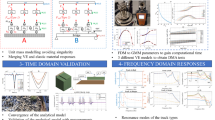Abstract
This study investigates a multibody dynamic model for predicting changes in dynamic responses based on the hardpoints and torsion beam properties of a coupled torsion beam axle (CTBA). This model applies beam elements to torsion beams that experience large deformations, and it applies rigid bodies to other parts such as the spring mount, trailing arm, and knuckle. For beam element modeling, the Timoshenko beam theory is used. The performance of this model was evaluated through a roll simulation and virtual testing lab (VTL), and it was compared to a flexible body CTBA model and validated. The validation results showed that the two models’ output errors were within 3% and 10% in the two test modes, respectively. This confirms that accuracy of the beam element based CTBA model is as high as that of the flexible body CTBA model. In addition, an effect analysis based on the design of the experiments (DOE) was performed on the hardpoints and torsion beam properties of the CTBA as an application case for the beam element based CTBA model. These application cases show that a beam element based CTBA model can be easily used to perform experiments for predicting system performance according to changes in hardpoints and torsion beam properties even when the shape of the CTBA is not determined.















Similar content being viewed by others
Abbreviations
- A :
-
Cross sectional area (m2)
- C :
-
6 × 6 Damping coefficient matrix
- E :
-
Material Young’s modulus (Pa)
- G :
-
Material shear modulus (Pa)
- J :
-
Torsional constant (m4)
- I yy :
-
Cross sectional inertia yy (m4)
- I zz :
-
Cross sectional inertia zz (m4)
- L :
-
Beam length (m)
- ASY :
-
Cross sectional shear factor in the y direction
- ASZ :
-
Cross sectional shear factor in the z direction
- Q y :
-
First moment of cross-sectional area to be sheared by a force in the z direction
- Q z :
-
First moment of cross-sectional area to be sheared by a force in the y direction
- l y :
-
Cross section dimension in the y direction
- l z :
-
Cross section dimension in the z direction
- P y :
-
Correction factor (shear area ratio) for shear deflection in the y direction for Timoshenko beams
- P z :
-
Shear area ratio for shear deflection in the z direction for Timoshenko beams
- F x, F y, F z :
-
Beam forces in x, y, z direction
- T x, T y, T z :
-
Beam torques in x, y, z direction
- dx, dy, dz :
-
Beam relative displacement in x, y, z direction
- θ x, θ y, θ z :
-
Beam relative angle in x, y, z direction
- V x, V y, V z :
-
Beam relative velocity in x, y, z direction
- ω x, ω y, ω z :
-
Beam relative angular velocity in x, y, z direction
References
Chen, J., Jiang, Y., Qin, M., Hao, W., Chang, Y. and Jin, L. (2015). CAD/CAE and optimization of a twist beam suspension system. SAE Technical Paper Series.
Chen, J., Qin, M., Jiang, Y., Jin, L., and Chang, Y. (2015). Modeling, analysis and optimization of the twist beam suspension system. SAE International Journal of Commercial Vehicles, 8, 38–44.
Choi, B., Choi, D.-H, Min, J., Jeon, K., Park, J., Choi, S. and Ko, J.-M. (2009). Torsion beam axle system design with a multidisciplinary approach. International Journal of Automotive Technology, 10(1), 49–54.
Fichera, G., Lacagnina, M., & Petrone, F. (2004). Modelling of torsion beam rear suspension by using multibody method. Multibody System Dynamics, 12(4), 303–316.
Kobelev, V. (2018). Durability of springs. Cham: Springer.
Lyu, N., Park, J., Urabe, H., Tokunaga, H. and Saitou, K. (2007). Design of automotive torsion beam suspension using lumped-compliance linkage models. In Anonymous ASME 2006 International Mechanical Engineering Congress and Exposition American Society of Mechanical Engineers Digital Collection (pp. 219–228).
Acknowledgements
This research was supported by Basic Science Research Program through the National Research Foundation of Korea(NRF) funded by the Ministry of Education (5199990814084).
Author information
Authors and Affiliations
Corresponding author
Additional information
Publisher’s Note: Springer Nature remains neutral with regard to jurisdictional claims in published maps and institutional affiliations.
Rights and permissions
About this article
Cite this article
Hyun, M., Yoon, J., Lee, J. et al. Development of Coupled Torsion Beam Axle Dynamic Model Based on Beam Elements. Int. J. Precis. Eng. Manuf. 22, 107–121 (2021). https://doi.org/10.1007/s12541-020-00431-8
Received:
Revised:
Accepted:
Published:
Issue Date:
DOI: https://doi.org/10.1007/s12541-020-00431-8





